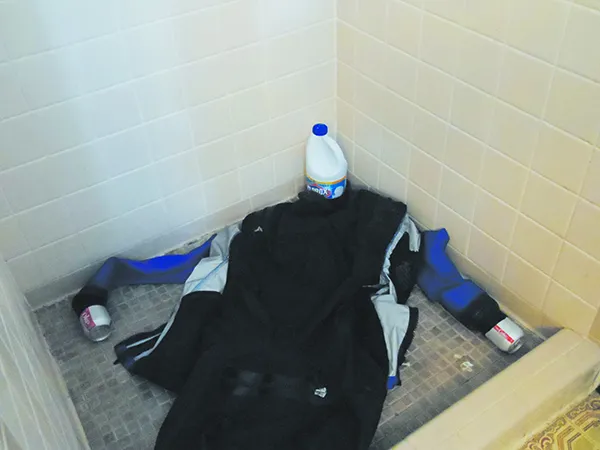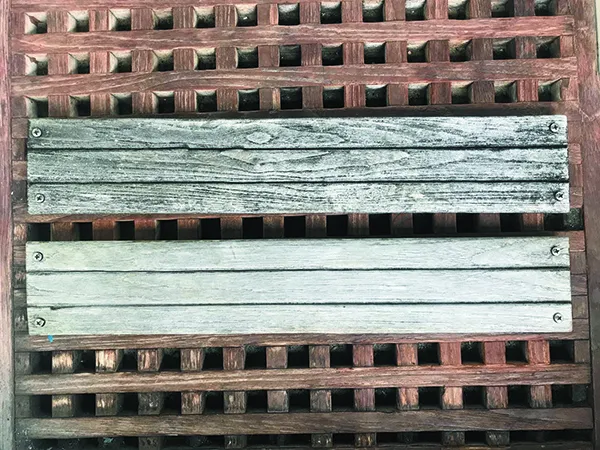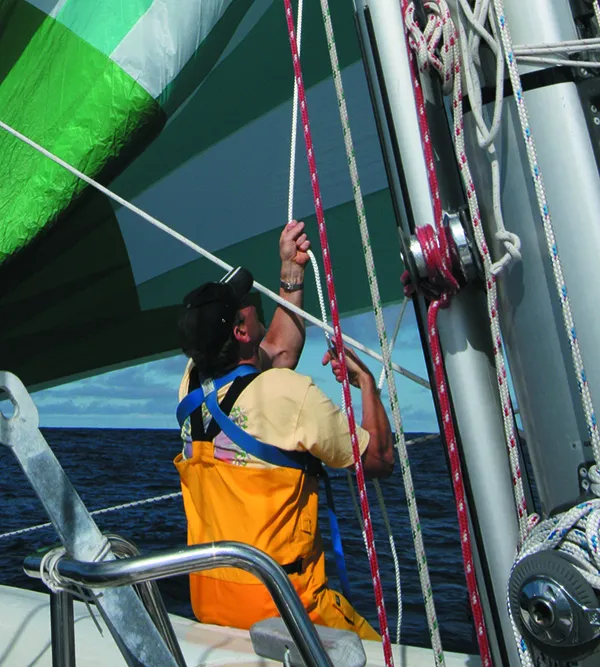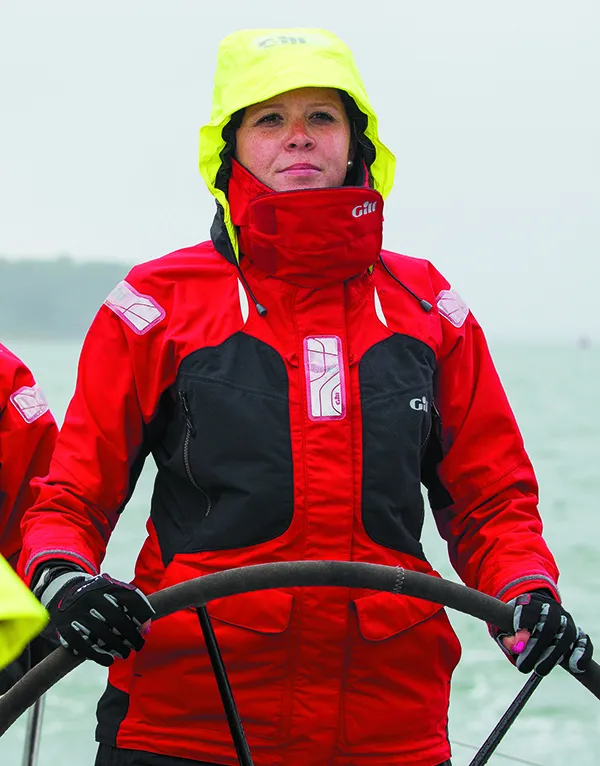I’m a big fan of drysuits for cold weather sailing (see “Soul Drysuit 2-year Update,” PS February 2016). But I’m not a fan of the odors they can acquire after use. Worse yet, I habitually leave the gear on the boat, often wet and seldom rinsed. However, through a few tricks of chemistry I’ve been able to avoid the worst of the stench. And these lessons apply equally to boots and sneakers.
The smell is caused by bacteria feasting on dead skin cells and oils left behind. Bacteria require water, so dry your gear. As with control of odor in boats, this is rule one, two, and three. At the very least, leave the suit unzipped and open, and inside-out if you can. In a perfect world we would take the gear home, rinse it with fresh water as soon as possible, and dry it thoroughly . . . like that’s going to happen. More likely, we’re tired and we’re not hauling wet stuff home to rinse and dry, just to bring it back again. And even if rinsed and dried, we’ll leave our suits on the boat, in a less than optimum setting, because that’s where we’re going to need them and they’re not going to do us much good at home.
Unless you have leaks that need fixed, the only source of water and dirt on the inside is you. Avoid sweating by peeling layers early. Try to wear at least one thin layer under the suit to reduce body oil, dead skin, and sun screen deposition. Avoid excessive washing, since this will only result in the removal of the durable water repellent (DWR) coating—more on this later. Since boats are a relatively clean environment, a dry suit that is kept dry should very seldom need washing.
I do haul my boots and shoes home. The only way to dry them quickly enough to prevent the stink is with a heated boot dryer. See “The Sailor’s Boot Drier,” PS February 2019, for a review of shoe and coat driers.
Cleaning Observations
Synthetics attract and accumulate fats, oils, and proteins, but the gentle detergents recommended for Gore-Tex and other garments with durable water repellent coatings (DWR) are specifically formulated not to degrease effectively. Unfortunately the DWR treatment is a distant cousin to grease and anything that will remove ground in grease and body oils will also remove the waterproof treatment. Without the DWR coating, the fabric will not bead water, and wetted fabric cannot breathe.
Protect waterproofness. Use soaps that won’t compromise the DWR. The DWR also helps the suit dry faster, which reduces odor potential. The term “mild detergent” as used by foul weather gear manufacturers deserves some explanation.
It does not mean to use just a little soap, one that is color-safe, or even dishwashing detergent or shampoo, which are often suggested. It means using a cleaning agent that is specifically designed not to act as an aggressive degreaser. By using special Gore–Tex washes or Woolite (formulated to avoid removal of the natural lanoline in wool) you can leave most of the DWR in place.
Hand wash. Open the zippers and wash right side out, and then inside out. If you do not turn the suit inside out there will almost certainly be air pockets which will not be washed. Put the feet in first or they will just hold air. Never use a machine. Some recommend front-loading machines on gentle cycle, but latex seals and waterproof zippers are just too vulnerable. Rinse twice—any residual soap, including any on the inside where the rain can’t rinse it off, will reduce water repellency and can increase leakage. Leave the zippers open and dry well. Again, you will need to turn it inside-out to get it dry. You can use the tube attachment on a boot drier to blow air into the feet, but don’t use a tumble dryer and don’t even consider a heated dryer. Again, the latex seals are vulnerable.
If the mildew is advanced, try Formula B at half concentration (see “Formula B” and “Homemade Mildew Preventers That Really Work,” Practical Sailor, June 2018). Soak for 20 minutes and scrub lightly.
Never use bleach or other chlorine-containing cleaners. Leave residual stains alone; this is rugged wear, not office wear. Never use fabric softeners. They only clog the pores.
About every three or four washings the DWR will require refreshing. Many treatments require the heat of a clothes dryer to be activated—read the instructions. Because the latex and neoprene drysuit seals and dry zippers can be severely damage by heat, do not use products that require heated drying.
Two products that I like, Nixwax TX Direct and Gear Aid ReviveX spray-on durable water repellent (DWR) treatments do not require heat activation. We also use Nikwax on our boat canvas and some lines to protect from mildew (see “Keeping Canvas in Tip Top Shape,” PS February 2014).
Use only products that have no perflourocarbons (PFCs). PFCs have been identified as carcinogenic and toxic chemicals that persist forever in the environment and can be dangerous in even small amounts. (The current EPA drinking water advisory limit, for example, is 70 parts per trillion). Patagonia recommends only spray-on products for Gore-Tex. Gore-Tex says wash-in products are OK, but we think spray-on makes more sense.
The suit should be dry before applying. Technically, you can apply them wet, but it’s harder to gauge coverage and they soak in better dry. A second coat on the seat and knees may or may not help.
Treat the gaskets and zippers with 303 Aerospace Protectant, a product universally recommended by dry suit makers. This was one of our top picks for clear vinyl as well (see “Protecting Clear Vinyl Windows,” PS December 2013).
We keep a spray bottle of pre-diluted BAC and a smaller bottle of pre-diluted GoldShield on the boat for PFDs, harnesses, rain gear, and smelly lockers. But dry suits are a challenge. It is easy to miss spots, and most drips off. It is less wasteful to treat the suit insitu. Leave it right-side out, close the zipper, and plug the cuffs with soda cans and the neck with a ½-gallon bottle. Pour a quart of solution into the suit and slosh it around. See “Biostatics” in article text for full discussion.
- A tub or shower simplifies treatment. The suit is allowed to soak for a few hours before hanging up to dry. Bottles and cans seal the suit.
- The bottom teak panel was treated with the biostatic Gold Shield 75, which proved highly effective to keeping mildew at bay.


What We Tested
The above is a mix of conventional wisdom, manufacturer recommendations, and what has worked for us. But our readers asked that we look a little deeper into products that could reduce the stink that settles between washings. My day job as an engineer has had me looking at disinfectants that will help fight COVID-19, so we tested a few products on rain gear, dry suits, and even sneakers and boots. Products like Microban are well known for their ability to tame polyester shirt stink.
Biostatics
There are biostatic products that prevent the growth of odor-causing bacteria. They won’t, however, prevent transfer of stink through smelly clothes or remove odor that is imbedded in the fabric.
Usually you can spray them on. We keep a big spray bottle of pre-diluted BAC and a smaller bottle of pre-diluted GoldShield around for PFDs, tethers and harnesses, and other garments, and spot use on the boat. But dry suits are all corners and wrinkles. It’s easy to miss spots.
I’ve found it faster and less wasteful to treat it right-side out, seal the zipper, plug the cuffs and with soda cans and the neck with a ½-gallon bottle, and pour quart of solution into the suit. Slosh it around until you are satisfied everything is wet, and pour out the excess (save the dregs—you can re-use them for PFDs, ropes, and the like).
Buy Suit Odor Treatments
| MANUFACTURER FORMULA B | GOLDSHIELD | WET-AND- FORGET | FORMULA B |
|---|---|---|---|
| MODEL | GS75 | Moss, Mold, Mildew & Algae Stain Remover Concentrate | DIY Formula |
| ACTIVE INGREDIENTS | S Organosilane | BAC | Borax & washing |
| PRICE | 56 | 30 | $2.40 (depends on mix volume) |
| AMOUNT | 128 oz. | 128 oz. | 24 oz. |
| DILUTION RATE | No dilution | 3 oz. per quart | As formulated |
| COST AS USED | 43 cents/oz. | 2 cents/oz. | 1 cent/oz. |
Formula B
Introduced in Practical Sailor and tested on basement carpets, fabric cabin liners, sails, clothing and PFDs, and bilges more times that we can count, this has long been our go-to for mildew remediation and prevention. However, while it works very well for cleaning hard surfaces and pile synthetics, and prevents mildew in natural fibers, it washes off of synthetics too easily. Although we recommend it for cleaning mildewed sails and foul weather gear, we do not recommend it as a mildew and bacteria preventative (biostatic).
Bottom line: Not our first recommendation.
Wet-and Forget
Formulated to kill algae on roofs and masonry, it is just a 10% benzalkonium chloride (BAC) solution. Dilute 3 ounces into 1-quart of water to make a 0.9% solution, which will leave an effective preventative coating.
Bottom line: A Budget Buy for mildew and odor control around a boat. Keep it handy in a quart spray bottle.
Marine GoldShield GS5/GS75
Dow Chemical began researching organosilane chemistry more than 50 years ago, in the search for durable antimicrobial treatments. A second cousin to BAC and more closely related to the Microban Aegis Microbe-Shield system, GoldShield resists wash off, so you don’t need to retreat every time you wash. It’s not cheap so, save the leftovers for next time. Better yet, dilute it a little more and use a spray bottle. (See “Tips and Technique,” page 17).
Bottom line: This is our Best Choice in lasting odor control.
Odor Removal
The following products won’t prevent the return of biological growth that causes odor, but they may be helpful if cleaning alone didn’t freshen things up.

February 2015), but there are also some cheaper options. See Practical Sailor blog, “Bracing for Cold and Wet Sailing.”
Manufactures will recommend returning damaged foul weather gear for evaluation, and in some cases there may be remedies under warranty. One the other hand, the gear may be well used, the damage your own darn fault, or you’re cruising and need a fix right now. We’ve long stretched gear to the limit, and these are some things that have worked for us.
Sail repair tape can work surprisingly well, at least for a while. Get it dry. Round the patch corners to ½-inch radius. Secure one side with any old tape to line up the edges and hold it flat and wrinkle free. Apply the first patch and rub down lightly. Remove the holding tape, apply a matching patch to the other side, and rub the patches down hard with a seam rubber. Covering the patches with the release paper while rubbing will keep them from wrinkling or lifting. Focus on the edges, working from the center outwards.
Sewing works, but it will leak. Best reserved for seam areas when extra strength is needed.

Adhesives. First, pull the edges together with tape from the outside. This way the adhesive residue won’t interfere with the internal patch. Scrub with detergent or wipe hard with solvent to remove all the durable water-repellent treatment (DWR). Like wax, glue won’t stick to it either.
Polyurethane adhesives work in damp conditions (water is the curing agent), but the fabric cannot be soaking wet and they are slow. Wipe and pad the fabric with dry towels until not overly damp.
The patch should extend at least 5/8-inch beyond the damage in all directions, and the corners of the patch should be rounded to a ½-inch radius. Coat the repair area with a thin layer, just enough to cover the texture of the fabric. Coat the patch with a slightly thicker layer and rub it down firmly, working outwards from the center. Used Sunbrella is our favorite patch material; it is tough and bonds well. New fabric will resist bonding due to the water-repellant coating.
Adhesive patches can be stronger than a sewn repair, because they do not depend on the integrity of old worn cloth. I’ve run these patches through the laundry countless times on all sorts of work clothes; they outlast the garment, every time. But even in warm weather, several days must be allowed for curing, depending on the product. 3M 4200 Fast Cure and Sika 291 fast cure to a usable state in 24 hours, while 3M 5200 and Loctite PL S40 take several days. Full strength takes about three times longer in all cases. Higher temperatures help.
Aquaseal FD, recommended by Patagonia and Marmut, is another polyurethane, but thinner and faster curing. The accelerator reduces cure time to two hours. Good if you are in a hurry.
OxiClean
Although bleach is a big no-no, OxiClean is based on peroxide and is safe for major cleanings. It will remove the DWR and it is not something we would use more than once every few years. Don’t exceed recommended concentration and do soak for at least 2 hours.
- 1 quart hot water
- 2 tablespoons baking soda
- 2 tablespoons Borax
- 1 tablespoon TSP
Odor neutralizers. Covering bad smells with perfume is a waste of time, but odor neutralizers are actually based on established science. Metazene (dodecyl methacrylate or laurel methacrylate) and hydroxypropyl beta-cyclodexitrin are known to encapsulate odor-producing molecules, reducing our perception of them.
Products such as Febreze and Arm and Hammer Odor Defense Shoe Refresher will work with minimal perfumes (the active ingredients themselves have a faint witch hazel sort of smell).Unfortunately, disclosure of non-hazardous and non-pesticide ingredients is not required, so the truth of some claims is hard to verify.
Enzyme products
We’ve also heard good things about Sink-the-Stink and Mirazyme, both of which are bacteria/enzyme based products that “eat” the stink. And some swear by pet odor removal products.

Conclusion
Dry is best, but when that doesn’t happen, a spray bottle of BAC or other fabric-compatible anti-bacterial can be your friend. We started leaving big spray bottles around when COVID-19 first struck, but soon realized they were darn handy for mildew and odor prevention on a variety of clothing—PFDs, foul weather gear, boots. Even the insides of damp cabinet, anchor lockers, and bilge areas.
Cleaning, drying, and ventilation should always be the first line of defense. Don’t go nuts with chemicals. But stink and mildew aren’t good for you either, and a spritz of BAC or Gold Shield now and then can help keep the microbes at bay. A spritz of odor-neutralizer when you are done can’t hurt.
Drew Frye is technical editor of Practical Sailor. He blogs at www.sail-delmarva.blogspot.com
GOLDSHIELD, www.goldshield1.com
WET AND FORGET, www.wetandforget.com


































Folks, This is one of the best publications I have ever subscribed to. I don’t always have time to read all the articles that you send, but I observe that they cover a very wide range of important topics. Many times the topics are useful, not only for sailors, but for everyone. I just read “Taking the Stink Out of Dry Suits”, and as usual, it was very thorough. It would also be relevant to anyone who owns Gortex. Keep up the good work. You folks are doing a great job.